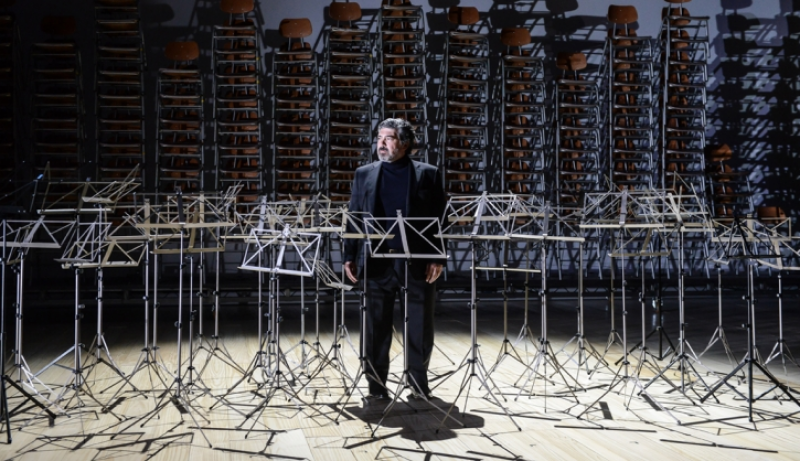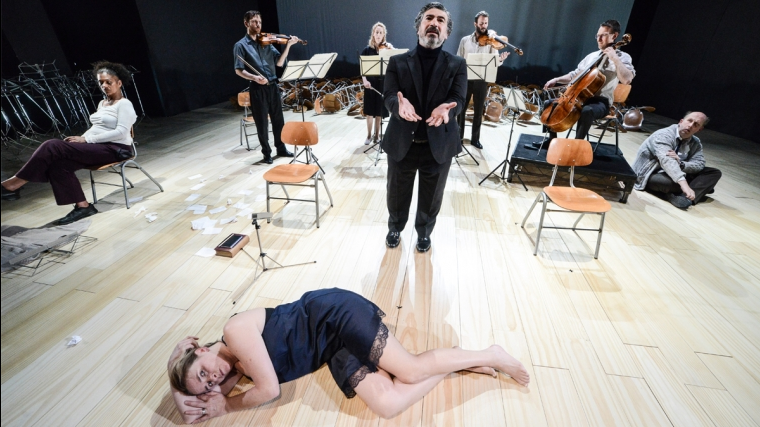The String Quartet’s Guide to Sex and Anxiety, Brighton Festival review - molto nervoso | reviews, news & interviews
The String Quartet’s Guide to Sex and Anxiety, Brighton Festival review - molto nervoso
The String Quartet’s Guide to Sex and Anxiety, Brighton Festival review - molto nervoso
Calixto Bieito's melange of text and music delivers a mesmerising riff on desolation

Calixto Bieito has a reputation as a radical theatre-maker, and by any standards The String Quartet’s Guide to Sex and Anxiety is an unusual, genre-breaking piece; Bieito has described it as “like a symphonic poem for a quartet of musicians, and a quartet of voices”.
The production is a joint venture between the Birmingham Rep and the Brighton Festival, and must have brought input from all involved in its creation. But the “creator”, as he is credited, the prime generator of ideas, was clearly Bieito, who has written of his past experiences with anxiety disorder. From him, we assume, came the choice of texts – the words are drawn from the likes of Robert Burton’s Anatomy of Melancholy and Korean-German philosopher Byung-Chul Han’s contemporary The Burnout Society, Swedish existentialist Stig Dagerman and Danish philosopher Søren Kierkegaard, and a variety of poets, WH Auden prime among them – as well as their assembly and ordering, and setting to music, initially (and dominantly) Ligeti’s String Quartet No. 2, followed by Beethoven’s Quartet No. 15, the “Serioso”.
Text somehow draws in music, as Yerolemou opens the show (main picture), lights in the somehow incongruously grand Theatre Royal still up, with a recitation of Burton; he’s certainly statuesque, but arguably lacks a desired richness of voice. A jumble of music stands surrounds him, with metallic chairs piled in high stacks behind, both to be absorbed into the developing spectacle (you are unlikely to have seen a music stand used quite like this before). Then Yerolemou’s fellow actors join him, stalking out the front stage space, the quartet materialising in the middle ground. It’s a moot point, considering the title, as to whether the quartet is in fact the guiding element, whether it accompanies the text (in a supporting capacity) or is an equal partner to it. But the fragmented text is matched ideally to the frantic, wiry whispering of the Ligeti, a balance modified with the appearance of the Beethoven around the hour mark.
Then Yerolemou’s fellow actors join him, stalking out the front stage space, the quartet materialising in the middle ground. It’s a moot point, considering the title, as to whether the quartet is in fact the guiding element, whether it accompanies the text (in a supporting capacity) or is an equal partner to it. But the fragmented text is matched ideally to the frantic, wiry whispering of the Ligeti, a balance modified with the appearance of the Beethoven around the hour mark.
The broad effect is of elements threading together, attaining varying degrees of consonance and discord. The relationship between the actors is fragmentary – each either involves, or separates him or herself from what the others are doing (pictured above), the impression being that of handing on a monological baton. It’s not just Mairead McKinley’s Irish accent that recalls Beckett, as she accomplishes what can only be termed a “fellatio monologue”, an agony of emotional uncertainty that is nevertheless played out with almost mechanical precision.
It builds to an almost unbearable concentration, with surely a hint towards redemption
Elements of comedy – Bieito has said that he wants The String Quartet’s Guide to be “entertaining and enlightening” – come to the fore when the cardigan-clad Nick Harris continues. He embarks on a marvel of lists, strange aggregations of symptoms and phobias, philosophical references set against a veritable shopping list of medications (not to mention that oldest-fashioned remedy, booze). Then it’s over to Tyson, who compels with the lucidity of her rendition of Dagerman’s “To Kill a Child”, its fluidity ebbing and flowing perfectly. She achieves such stillness, one that contrasts with the tactile agonies that follow her.
Trying to sum it up in words is surely redundant, though “mesmerising” remains as good a description as any. Better to leave it with some of the musical terms dotted through it, pizzicato tragismo, allegro con delicatezza, asai vivace mai serioso among them. “Suicides have a special language,” wrote Anne Sexton, whose work appears here, and it’s with such laconic Italianate flourishes that Bieito marks the rises and falls of his piece.
It builds to an almost unbearable concentration, with surely a hint towards redemption. The String Quartet’s Guide demands total involvement, and when one's absorption is so complete, an element of catharsis is somehow inevitable. But perhaps it’s more consolation, as defined by Dagerman, whose words – “the need of consolation that dwells in a human being is insatiable” – resound at the very end of the evening. Or, as another poet, one not (I think) cited here but no stranger to south coast desolation, might have put it, a few more fragments shored against our ruins…
Below: Cathy Tyson in The String Quartet’s Guide to Sex and Anxiety
rating
Explore topics
Share this article
The future of Arts Journalism
You can stop theartsdesk.com closing!
We urgently need financing to survive. Our fundraising drive has thus far raised £49,000 but we need to reach £100,000 or we will be forced to close. Please contribute here: https://gofund.me/c3f6033d
And if you can forward this information to anyone who might assist, we’d be grateful.

Subscribe to theartsdesk.com
Thank you for continuing to read our work on theartsdesk.com. For unlimited access to every article in its entirety, including our archive of more than 15,000 pieces, we're asking for £5 per month or £40 per year. We feel it's a very good deal, and hope you do too.
To take a subscription now simply click here.
And if you're looking for that extra gift for a friend or family member, why not treat them to a theartsdesk.com gift subscription?
more Theatre
 Ragdoll, Jermyn Street Theatre review - compelling and emotionally truthful
Katherine Moar returns with a Patty Hearst-inspired follow up to her debut hit 'Farm Hall'
Ragdoll, Jermyn Street Theatre review - compelling and emotionally truthful
Katherine Moar returns with a Patty Hearst-inspired follow up to her debut hit 'Farm Hall'
 Troilus and Cressida, Globe Theatre review - a 'problem play' with added problems
Raucous and carnivalesque, but also ugly and incomprehensible
Troilus and Cressida, Globe Theatre review - a 'problem play' with added problems
Raucous and carnivalesque, but also ugly and incomprehensible
 Clarkston, Trafalgar Theatre review - two lads on a road to nowhere
Netflix star, Joe Locke, is the selling point of a production that needs one
Clarkston, Trafalgar Theatre review - two lads on a road to nowhere
Netflix star, Joe Locke, is the selling point of a production that needs one
 Ghost Stories, Peacock Theatre review - spirited staging but short on scares
Impressive spectacle saves an ageing show in an unsuitable venue
Ghost Stories, Peacock Theatre review - spirited staging but short on scares
Impressive spectacle saves an ageing show in an unsuitable venue
 Hamlet, National Theatre review - turning tragedy to comedy is no joke
Hiran Abeyeskera’s childlike prince falls flat in a mixed production
Hamlet, National Theatre review - turning tragedy to comedy is no joke
Hiran Abeyeskera’s childlike prince falls flat in a mixed production
 Rohtko, Barbican review - postmodern meditation on fake and authentic art is less than the sum of its parts
Łukasz Twarkowski's production dazzles without illuminating
Rohtko, Barbican review - postmodern meditation on fake and authentic art is less than the sum of its parts
Łukasz Twarkowski's production dazzles without illuminating
 Lee, Park Theatre review - Lee Krasner looks back on her life as an artist
Informative and interesting, the play's format limits its potential
Lee, Park Theatre review - Lee Krasner looks back on her life as an artist
Informative and interesting, the play's format limits its potential
 Measure for Measure, RSC, Stratford review - 'problem play' has no problem with relevance
Shakespeare, in this adaptation, is at his most perceptive
Measure for Measure, RSC, Stratford review - 'problem play' has no problem with relevance
Shakespeare, in this adaptation, is at his most perceptive
 The Importance of Being Earnest, Noël Coward Theatre review - dazzling and delightful queer fest
West End transfer of National Theatre hit stars Stephen Fry and Olly Alexander
The Importance of Being Earnest, Noël Coward Theatre review - dazzling and delightful queer fest
West End transfer of National Theatre hit stars Stephen Fry and Olly Alexander
 Get Down Tonight, Charing Cross Theatre review - glitz and hits from the 70s
If you love the songs of KC and the Sunshine Band, Please Do Go!
Get Down Tonight, Charing Cross Theatre review - glitz and hits from the 70s
If you love the songs of KC and the Sunshine Band, Please Do Go!
 Punch, Apollo Theatre review - powerful play about the strength of redemption
James Graham's play transfixes the audience at every stage
Punch, Apollo Theatre review - powerful play about the strength of redemption
James Graham's play transfixes the audience at every stage
 The Billionaire Inside Your Head, Hampstead Theatre review - a map of a man with OCD
Will Lord's promising debut burdens a fine cast with too much dialogue
The Billionaire Inside Your Head, Hampstead Theatre review - a map of a man with OCD
Will Lord's promising debut burdens a fine cast with too much dialogue

Add comment